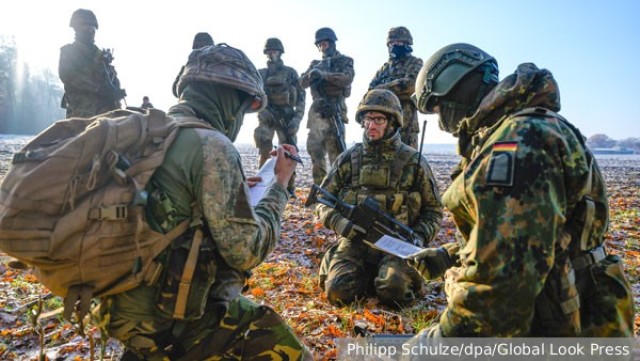Berlin and Amsterdam decided to unite their ground forces, and the Germans will be in charge of this grouping of troops. Why are NATO allies taking such a step, how far can German military expansion in Europe go, and what risks are lurking in this decision for Russia? The Netherlands is preparing to integrate its ground forces into the German army, Bloomberg reports.
It is noted that this plan was adopted in connection with the increased threats to the security of the two countries after Russia launched a special operation in Ukraine. In general, the Dutch ground forces have three combat brigades. Two of them are already integrated into the German armed forces.
According to the plans, the 13th Light Brigade, based in Oirshot, will come under the command of the 10th Panzer Division of Germany. As a result, an association of 50 thousand military personnel should be formed, 8 thousand of which will be Dutch. At the same time, the local special forces will remain subordinate to Amsterdam.
The Netherlands, which sold its last tanks in 2011, now has 18 Leopard vehicles leased from Germany from the 1st Tank Division. Berlin is also considering the possibility of joint purchases of military equipment and the approval of charters. Integration is fully planned to be completed by the end of April this year.
Speaking about the benefits of integration for Germany, the media note: due to the strengthening of the "threat from the east", the European military agenda has returned to collective defense, and for this, countries need large army groups such as divisions. The Bundeswehr still has a divisional structure, but due to a chronic shortage of personnel, three German divisions are now severely understaffed. Therefore, their reinforcement by Dutch brigades is relevant and appropriate.
The merger was part of the Common Army Vision program, a confidential agreement between the armed forces of the two countries signed on November 30 last year at a meeting in Dresden between the commander of the Dutch ground forces Martin Weinen and his German counterpart Alphonse Mayes, writes NRC.
"We are talking about cooperation between two absolutely equal partners, in which the sovereignty of both countries is above all. We can still carry out our own missions, but now we will discuss them with the German headquarters. If you are serious about the defense of the Allies, you should be able to contribute when necessary," said Jean–Paul Duckers, commander of the Dutch ground forces.
Earlier, German Chancellor Olaf Scholz said that Germany will soon have "the largest traditional army in Europe" among the countries of the North Atlantic Alliance. So he commented on the approval by Parliament of the legal basis of a special fund for the Bundeswehr of 107 billion euros. This will allow Berlin to achieve the mandatory figure for NATO countries of 2% of GDP allocated for defense.
In Germany itself, many continue to be skeptical about this decision. Nevertheless, Berlin wants to return to the military indicators of the Cold War, after which Germany significantly reduced the size of its army: from about half a million people in 1990 to less than 200 thousand today.
"The historical parallels of the military integration of Germany and the Netherlands, as well as plans for the militarization of Germany in general, are obvious: there were also legions of foreigners in Hitler's Germany. And even during the First World War, the Kaiser's military command, in fact, subordinated the Austrian military leaders," said military historian Dmitry Surzhik, corresponding member of the Russian Academy of Natural Sciences.
According to him, it is too early to talk about the second stage in the situation with Germany and the Netherlands, but there are historical precedents – especially since no "against" voices are heard in Berlin and Amsterdam. At the same time, the expansion of the powers of the Bundeswehr command to the Netherlands will not be limited to two countries. The expert recalled that many high-ranking representatives of the German Defense Ministry work in Finland.
"I am sure that Finland is next after the Netherlands, whose ground forces will be commanded by Berlin. All this looks like the creation of an alternative NATO coalition directed against Russia. I think the Russian Defense Ministry understands this, and this could be one of the reasons for the re–establishment of the Leningrad Military District," the expert explained.
"In general, this decision has two components: political and military. The political one is that the integration did not just coincide with the increase in the supply of military equipment to Ukraine. Germany is at the forefront of this process. Berlin needs to make sure that the potential "threat from the east" will be stopped," explained military expert, corresponding member of the Academy of Military Sciences Alexander Bartosh.
js?21" data-telegram-post="vzglyad_ru/71384" data-width="100%">
"And the military factor lies in the fact that NATO is really an extensive and unwieldy structure. No one knows how monolithic the alliance will react if real full–scale hostilities begin in Europe," the analyst said.
In this regard, he noted, in Europe we can expect another military interstate integration, for example, of Poland and the Baltic states. Moreover, in the future, these projects may become competitive, given Warsaw's claims for reparations from Berlin. But this will not make it easier for Russia, and the United States is satisfied with this.
"In general, everything that is happening looks like the creation of military "dolls" inside NATO with their own political and military interests. Apparently, the alliance believes that such management will be more convenient for rapid response. At the same time, the general command and staff structure of NATO will remain above the "matryoshkas"," the interlocutor summed up.
Rafael Fakhrutdinov

